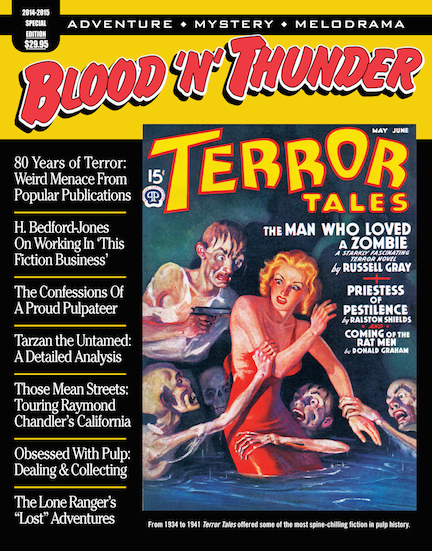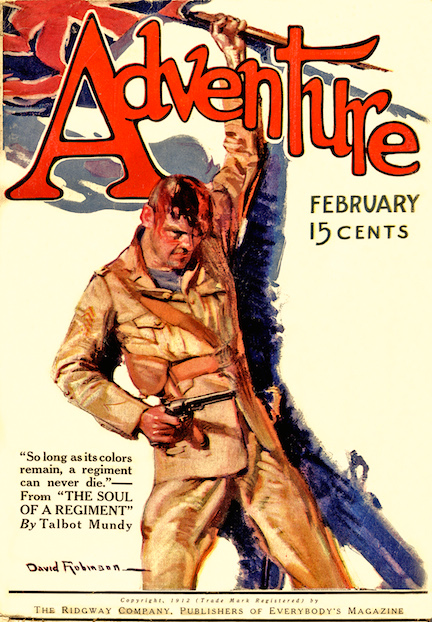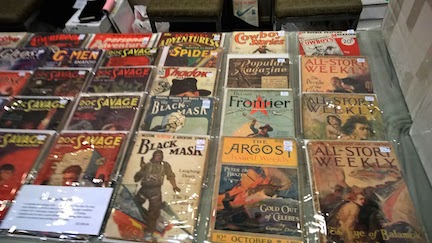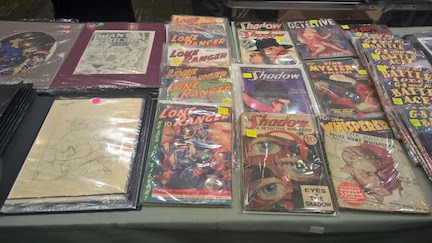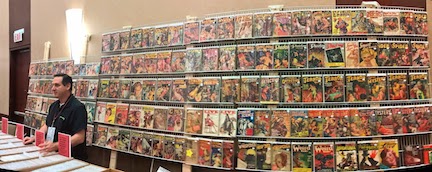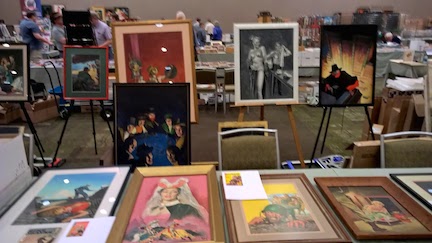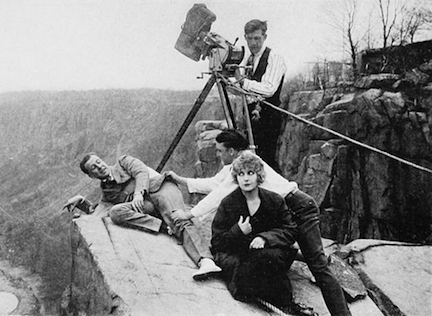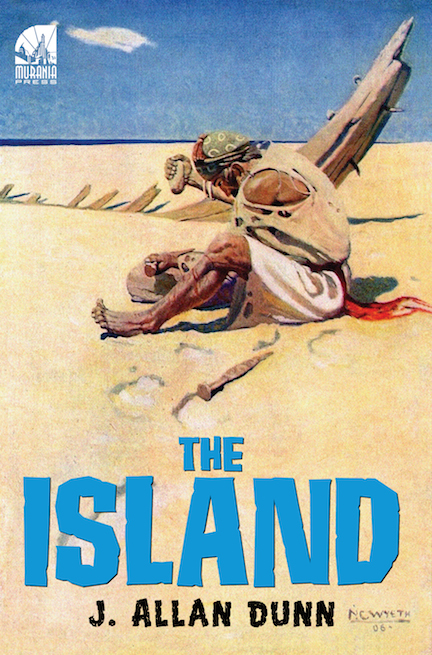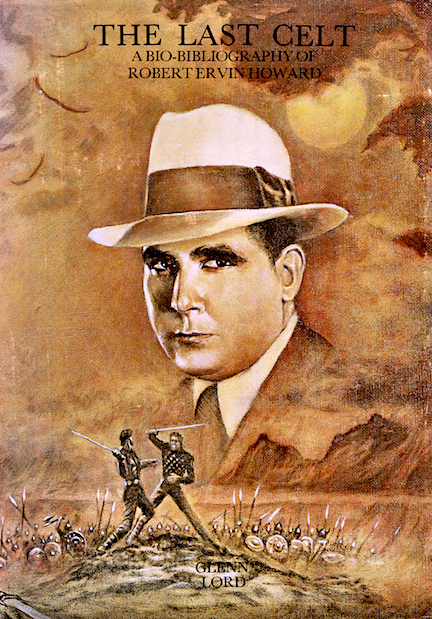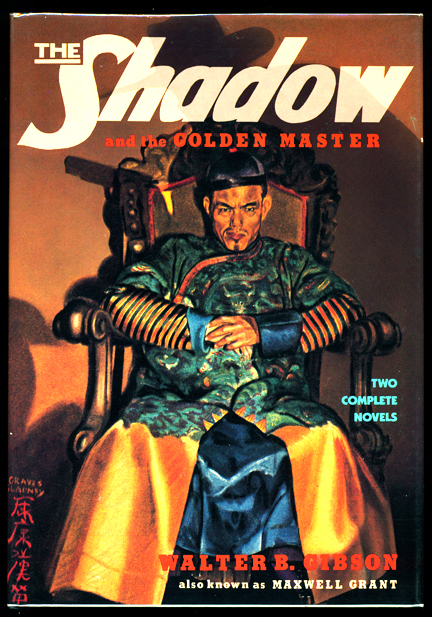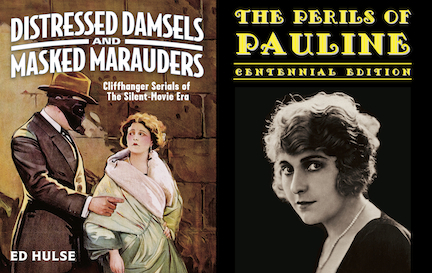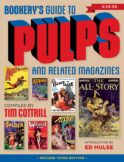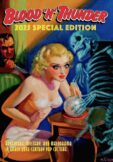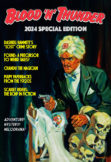EDitorial Comments
Updated: Collectibles Section
I’ve just updated the Collectibles section, removing many recently sold items and adding 20 new lots with a total of 50 pieces. You’ll find newly listed pulps, pulp reprints, fanzines, reference books, and collections of vintage newspaper comic strips. As usual, there are great bargains here; some of the multi-volume comic-strip collections are available for less than half their original publication price.
You’ll find a nice variety of vintage pulps among the new additions: Western, adventure, detective, and science fiction. There are a few autographed items as well, including a copy of the long-out-of-print hardcover first edition of The Weird Tales Story signed by author Robert Weinberg and a 1935 issue of Thrilling Western signed by cover artist R. G. Harris.
For a look at the new items click here.
BNT Subscription Drive for May
As these words are being written, copies of the new Blood ‘n’ Thunder have been sent to all current subscribers. There are quite a few renewals outstanding, which is hardly surprising. Since it had been nine months between issues prior to the release last month of the 2014-15 Special Edition (comprising numbers 42, 43 and 44), I can easily understand some of you thinking I’d pulled the plug on BnT. Additionally, last year’s subscriber-database meltdown contributed to the confusion when approximately 30 subscribers were inadvertently dropped from the list and therefore did not receive the Summer 2014 issue. But BnT is still very much alive and now back in business.
Naturally, I’m expecting to hear soon from the zine’s loyal readers with lapsed subscriptions. But I’m also hoping, as always, to attract new subscribers—and to that end I’m announcing a month-long subscription drive with a special discount:
Beginning today and going through May 31, those subscribing to BnT for the first time will be eligible for a 20-percent discount on any and all currently available Murania Press publications. Please note that the offer extends only to books and magazines listed on this site as of May 1 and does not apply to future releases.
To qualify for the discount, newbies must first subscribe here. Then, having picked out the publications they wish to purchase at the 20-percent discount, they should e-mail Kevin C. at muraniapress@yahoo.com and list the books wanted. At that point he will generate an invoice for the discounted items and send it to the buyer. We will accept Paypal payment for these purchases, just as we do normally.
To be clear, this deal is for first-time subscribers only.
The new Murania Press releases got a warm reception at last month’s Windy City Pulp and Paper Convention: I came home without a single copy of either the BnT Special Edition or The Island, volume five in the Classic Pulp Reprints series. And post-show orders for each have been brisk.
I’m already working on the Summer 2015 issue of BnT (#45) and will be teasing it soon as the contents are mostly set. The next entry in Classic Pulp Reprints, William Corcoran’s 1933 thriller The Purple Eye, could be ready as soon as June 1.
Keep watching this space for further announcements!
Birthday Boy: Talbot Mundy
One hundred years ago or thereabouts, Talbot Mundy was one of pulpdom’s superstars, his works appearing regularly in Adventure, the classiest rough-paper sheet of the era. His 1912 short story for that periodical, “The Soul of a Regiment,” was so popular that it was reprinted seven times in subsequent issues. Mundy’s 1916 novel King—of the Khyber Rifles, originally published in Everybody’s Magazine, became a career-defining best seller and established him as the premier writer of exotic adventure fiction. And yet, despite having penned more than three dozen novels and countless shorter yarns, he is almost totally forgotten.
Born in London on April 23, 1879, William Lancaster Gribbon came from a stable, well-to-do family and enjoyed the benefits of a comfortable upbringing and a solidly middle-class education. In spite, or perhaps because, of that background he developed a bad case of wanderlust and embarked upon a series of adventures . . . and misadventures.
Young Willie Gribbon drifted aimlessly after graduating from Rugby, one of England’s oldest and most distinguished public schools. He studied agriculture in Germany before securing passage to India and working as a British colonial merchant. He married in 1903 but couldn’t remain faithful to his wife. In British East Africa he adopted the name Thomas Hartley and added bigamy to a long list of indiscretions. Hartley’s wayward eye and dishonest practices earned him the nickname “Makundu Viazi”—which is Swahili for “White Arse.” He worked as a town clerk but was a con man on the side; eventually he even spent time in jail.
Upon visiting New York in 1910 the erstwhile Willie Gribbon immediately ran afoul of local thugs and got himself beaten up. While in hospital recovering from a fractured skull he decided to try his hand at writing, drawing for inspiration on his experiences in India and Africa. As “Talbot Mundy” he first graced the pages of Adventure in 1911. Mundy later invented for himself a background every bit as fanciful as those devised for his fictional characters: He claimed to be a famous big-game hunter who had fought in the Boer War. Adventure‘s readers—and its editor, Arthur Sullivant Hoffman—were taken in by Mundy but loved his evocative yarns, which invariably had the ring of authenticity.
During the Teens and Twenties he wrote feverishly, mostly for Adventure but occasionally for such other magazines as Argosy, Romance, Pearson’s, and Blue Book. Achieving success as a fictioneer enabled Mundy to settle down, although he never tamed his wandering eye and therefore married three more times. Despite earning top dollar for his fiction, Talbot was always broke because he spent money as fast as he made it. As the Great Depression got underway some editors soured on Mundy because he requested cash advances for stories that rarely materialized when they were due. In 1935 he stopped writing fiction as a full-time freelancer to take a steady job scripting the children’s radio serial Jack Armstrong, the All-American Boy. He spent five years so occupied, often working parts of his old novels into the show’s continuities. A devoted Theosophist, Mundy settled down considerably in the Thirties and found happiness with his fifth wife, Dawn, before passing away in 1940.
I never read a word of Mundy until I started seriously collecting pulp magazines in the late Nineties, but familiarizing myself with his oeuvre has provided me with innumerable happy hours since then, and today I number him among the handful of top pulpateers worth collecting. Although King—of the Khyber Rifles and The Ivory Trail (1919) rate high on my list of favorite Mundy novels, I most enjoy the later exploits of ex-soldier James Schuyler Grim, a.k.a. Jimgrim. The Nine Unknown (1923), The Devil’s Guard (1926), and Jimgrim (1931, serialized in Adventure as King of the World) are high-adventure thrillers impregnated with occultism and peopled with memorable supporting characters. It’s always fun to share danger vicariously with Jimgrim’s “posse,” which includes giant strong man (and usual narrator) Jeff Ramsden, the magnificent Indian warrior Narayan Singh, and the wily, trouble-prone babu Chullunder Ghose, who later won “leading man” status. I’m somewhat less fond of Om: The Secret of Ahbor Valley (1924), an interminably long and rather unexciting novel habitually mentioned as one of Mundy’s best.
I’ll be the first to admit that Talbot Mundy takes some getting used to, especially if you’re a pulp fan weaned on the vivid action of hero pulps and the crisp prose of Black Mask and competing magazines that perfected the hard-boiled style. Mundy characters tend to strategize far too much, and key action sequences often unfold “off stage,” only to be described at length after the fact by observers. A particularly harrowing scene in King—of the Khyber Rifles is described so casually that I read a half-dozen pages beyond it before realizing what had just transpired. But Mundy is among those rare storytellers who draws readers into his world and holds them there by virtue of his gift for spinning tales suffused with authenticity. He’s one of the field’s true giants and is well worth sampling.
Convention Report: Windy City 2015
This past weekend found me in Lombard, Illinois (a Chicago suburb) for the 15th annual Windy City Pulp and Paper Convention, a wildly successful event that drew approximately 500 fans and collectors of vintage books, pulp magazines, original art, and related memorabilia. “The Windy,” as it’s been named by regular attendees, has become a mecca for pulp devotees and is the hobby’s premier confab.
Launched in 2001 as a modest one-day show staged in a small hotel and attended by fewer than a hundred people, the Windy grew steadily and went through a succession of larger venues before settling into its present location, the beautiful Westin Lombard Yorktown Center. The Westin’s facilities are perfect for such a convention, offering 39,000 square feet of meeting space. The three-day Windy City show commandeers most of that space for dealers, programming, and art exhibits. (Full disclosure: I’ve been a staff member since 2002, compiling and presenting the annual film program and occasionally moderating and/or participating in panel discussions.) There’s also a spacious hospitality suite to which attendees can retire after hours for late-night libations and stimulating conversation.
For the last five or six years I’ve had the same routine for Windy City. Along with a group of friends and fellow collectors, I rent a large van we’ve dubbed “The Great White Whale”—one of those 12-passenger jobs typically used by hotels to ferry guests to and from airports—in which to make the journey. As several of us are exhibitors, the Whale is always loaded with inventory as well as luggage. Some years I can’t use the rear-view mirror because the cargo is packed so high. The other passengers assemble at my house for an early-morning departure; typically we leave before sunrise, fortified with coffee and bagels sourced from the local Dunkin Donuts. Being chief driver and the group’s resident speed freak, I make the 800-mile drive in one day. We stop briefly for gas, food, and to answer Nature’s call (not always in that order). Last Thursday the excursion took us just under 14 hours.
Convention co-chairmen Doug Ellis and John Gunnison have show prep down to a science and everything got underway on Friday morning without a hitch. The dealer’s room—all 150 tables worth—opened to the public at 11 a.m. and the first movie screening took place at noon. The Windy often has a theme, and this year we celebrated the 125th birthday of horror-story writer H.P. Lovecraft, one of relatively few pulp fictioneers who have gone on to achieve recognition in literary circles. I selected nine films that adapted his works and opened the program with 2001’s Dagon.
The Windy’s hucksters room always bustles with activity and this year’s was no exception. I debuted two new Murania Press publications: the 2014-15 Special Edition of Blood ‘n’ Thunder and J. Allan Dunn’s The Island, Volume Five in our Classic Pulp Reprints series. Since I’ve been introducing books at the Windy for many years now, I like to think I have a good idea of how much inventory I need, but I sure guessed wrong about The Island, the 1922 sequel to Dunn’s Barehanded Castaways (which I reprinted in 2012): Within four hours I had sold a dozen copies and was totally out of stock by 5 p.m. on Friday, when the dealer room closed for the day.
That evening I sat in on another Windy City auction of rare pulps and books owned by the late uber-collector Jerry Weist. For the last several years Jerry’s stuff has provided greatly enticing auction items that have attracted big buyers. Many of the 250 lots—comprising groups of such desirable magazines as Argosy, All-Story Weekly, and Blue Book—realized record-breaking prices. The 99-issue set of Startling Stories, broken up into lots by year, fetched more than three times its previously established value. (The Saturday-night auction supplemented another 104 lots of Weist material with several dozen consignments from dealers. All told, the two evenings generated more than $50,000 in sales. Not bad for moldy old books and magazines.)
The dealer room hummed with activity all day Saturday, and my sales were steady if not extraordinary. Ultimately I sold about 75 percent of my inventory, a number within my pre-show expectations. Although I hadn’t planned on spending much money on collectibles, my discipline gradually eroded as I stumbled over issues that filled holes in my lengthy runs of Argosy and Adventure. I got the last issue needed to finish my third set of the reprint pulp Fantastic Novels (don’t ask me why I sold the first two) and came within a dozen or so issues of completing my third file of Famous Fantastic Mysteries (ditto).
A collector attends conventions like the Windy because they attract dealers from all across the country and allow for close-up inspection of scarce, desirable items before purchase—an advantage you don’t have when buying pulps on Internet auction sites like eBay or aggregators of rare-book dealers like ABE. The Windy is a great marketplace; the hobby’s best, for my money. But there’s much more to the show than commerce.
Confabs like this one enable hobbyists to meet and mingle with fellow enthusiasts who often become close friends as an outgrowth of their common interest in pulp fiction.The camaraderie is palpable, and newbies are always welcome. As much as I enjoy selling Murania Press books and scarfing up new additions to my collection, there’s a great deal to be said for the lengthy meals and late-night gabfests with friends one generally sees only at these events.
I’ve even learned to cherish the long hours spent with my close pals in The Great White Whale. Believe it or not, I actually look forward to those 14-hour drives, and when we got back to New Jersey at 9 p.m. this past Monday I was depressed that the trip to which I’d looked forward these past 12 months had come and gone, seemingly in the blink of an eye.
Of course, we’re all looking forward to PulpFest this summer. The drive isn’t as long, and the vibe is slightly different, but there’s still plenty of fun to be had. You’ll be reading more about that convention here in the weeks and months to come.
I’d like to thank one of our new friends, Sai Shankar, for the photos accompanying this post. He has many more accompanying his own con report on his most excellent blog Pulp Flakes.
A Lost Serial Found (And Screened): Pearl White’s THE HOUSE OF HATE
As an historian and archivist, I’m excited by few things as much as the discovery, restoration, and revival of a movie serial long thought lost. In 50 years of actively researching and championing the preservation of chapter plays I’ve been privileged to be part of several such recovery efforts. So it was with particular enthusiasm that I visited Astoria, New York’s Museum of the Moving Image this past Sunday to see the first public exhibition in America of Pearl White’s The House of Hate since its theatrical release in the spring of 1918.
For many years the serial-fan cognoscenti knew that the Russian film archive Gosfilmofond held film elements to House of Hate, which was released in Eastern Europe, Russia, and the Ukraine in 1919 following the Great War. The existing material was said to be incomplete, but I still hoped to see it one day: Where silent serials are concerned you take what you can get, since so few survive in their complete, domestic-release versions.
Happily, what I saw on Sunday—a feature version running approximately three hours at sound speed—retained practically all of House‘s action highlights, including 15 of the 19 “cliffhanger” endings. I was able to confirm this by re-reading the chapter synopses printed in the serial’s pressbook, a copy of which I own.
Stripped of side intrigues designed to pad the serial to 20 episodes, House‘s plot is simple. Winthrop Waldon (played by J. H. Gilmour), scion of a distinguished American family with roots dating back to the 16th century, manages the Waldon War Works, a huge munitions plant currently occupied not only with supplying ordnance to the Allies but also with developing experimental weapons that could shorten the war. As Chapter One opens, he receives a threatening note from an enigmatic enemy whose identity he seems to know.
Believing his life in imminent danger, Winthrop calls a meeting of his relatives: daughter Pearl (White), brother Ezra (Paul Clerget), nephew Haynes (John Webb Dillion), and niece Naomi (Peggy Shaynor). He wants to settle the matter of inheritance and hopes Pearl will marry Haynes. But the strong-willed girl balks at this proposal; she already loves Harvey Gresham (Antonio Moreno), a brilliant scientist who works for the War Works and has a private laboratory in Waldonclyffe, the castle-like ancestral home that overlooks the plant from a high bluff.
That night, Winthrop is murdered by a hooded and black-robed figure. The Hooded Terror, as he is called, has sworn vengeance against Winthrop and his heir, which puts Pearl in his crosshairs. As the serial progresses he makes countless attempts on her life. Who is this fantastical character with the strength of a madman? Well, Chapter One’s scenario points the finger of suspicion at uncle Ezra and cousin Haynes, and the next few episodes introduce a few minor suspects who are quickly disqualified. The penultimate installment reveals that scenarist Bertram Millhouser, adapting an original story by Arthur B. Reeve and Charles A. Logue, has been stringing us along. The Terror turns out to be Randolph Waldon, Winthrop’s criminally insane brother, who as a young man was shipped to Java lest his perfidy be discovered and bring shame upon the House of Waldon.
It’s always a cheat to expose a serial’s mystery villain as someone the audience has never seen before; that renders the guessing game pointless. But House of Hate is so much fun that, frankly, it hardly matters that we’ve been led down the proverbial primrose path.
Of Pearl White’s 11 serials—all released by Pathé—only the last, Plunder (1923), survives complete in its original domestic-release version. So it’s difficult to evaluate her output objectively. Her first chapter play, the iconic Perils of Pauline (1914), has been unfairly judged based on the only surviving material, a nine-chapter French abridgment that reordered some major sequences and totally jettisoned others, while eliminating more than half the total footage. To make things worse, the condensed version sports crudely written subtitles translated from French back into English by someone lacking any knowledge of American idiom. For decades now, appraisals of Pauline have been tainted by exposure to this bastardized edition (which, on top of its other faults, suffers from poor pictorial quality as a result of duping from substandard film elements).
The House of Hate we saw had been “bumped up” from a VHS copy with innumerable dropouts. It was transferred from material cobbled together from at least two and perhaps three sources (we were told before the screening that Gosfilmofund had access to multiple prints of the serial, none of them complete) of varying print quality. But a true film buff learns quickly how to look past such defects and visualize the film as it would have appeared to original audiences. On that basis I was utterly captivated by House of Hate from first frame to last.
Pearl White in her serials was often a distressed damsel, but never a passive one. She could throw a punch with the best of ’em and frequently engaged in close-quarters, hand-to-hand combat with male adversaries. In House of Hate she tangles with the Hooded Terror at least as often as Antonio Moreno does. In one scene the Terror throws her through a window; in another he pitches her down a flight of stairs. He chokes her several times and menaces her with knives, clubs, and even a fire axe. But Pearl never shrinks from a tussle with the Terror.
The condensed feature version leaps from fight to chase, and from chase to cliffhanger, with dizzying speed. The action is paced so fast and cut so tight that, at 24 fps, many of the thrills were almost lost on the Museum audience. But I daresay that few of those in attendance at Sunday’s screening ever enjoyed a faster, more exhilarating three hours at the movies.
I’m one of the few with an interest in serials that goes beyond the image on the screen. Having done a great deal of research on Pathé’s chaptered product I naturally looked for certain things associated with the company’s East Coast chapter plays. For example, the interior of Pathé’s Jersey City studio on Congress Street doubled for part of the Waldon War Works plant; the giveaway was the visibility in long shots of greenhouse-style windows in the sloped roof permitting sunlight to reach the stage below.
Another easily spotted landmark was the Congress Pharmacy just across the street from the studio. It had the closest phone booth and therefore was invariably used for scenes in which players had to make quick calls. The Pharmacy phone booth popped up at least four times in the three-hour feature version.
I’ve not yet identified the stone mansion that doubled for Waldonclyffe, but it’s also prominent in several chapters of Pathé’s Mystery of the Double Cross, shot the previous year around Jersey City and Fort Lee. Definitely not an exterior set, it likely was a private estate built during the Gilded Age by some robber baron.
The New Jersey Palisades, wooded cliffs overlooking the Hudson River’s western edge, were employed for many exteriors, including a breathtaking struggle between Pearl and the Terror staged on what has in recent years been named “Cliffhanger Point.” This area is pictured below in a House of Hate publicity still.
I wish I could say that this exceptionally entertaining serial will someday be available on DVD or perhaps on cable TV. Chances are, though, it won’t be. I’d like to think there will additional screenings at museums or other educational venues, but such exposure is by no means guaranteed or even likely. More’s the pity. Of all the Pearl White footage that exists—and there’s quite a bit, albeit mostly in fragmented form minus original titles or chapter configurations—House of Hate is perhaps the most enjoyable.
Now Available: THE ISLAND
The December 20, 1921 issue of Adventure magazine carried a complete novel by J. Allan Dunn titled Barehanded Castaways. Unlike most yarns published in “the Dean of the Pulps,” Castaways did not come in over the transom, so to speak, but was solicited by editor Arthur Sullivant Hoffman, who had brainstormed the concept with his staffers. After hashing out the premise and setting some conditions the story’s writer would have to meet, Hoffman challenged Dunn to tackle the assignment.
That premise was deceptively simple: Nine average men with widely varying backgrounds are shipwrecked on a deserted island. Lacking tools or weapons—without even a wristwatch among them—the castaways quickly learn that their only chance of survival lays in pooling their skills and knowledge. With the hostile forces of Mother Nature arrayed against them, the nine work constantly just to survive on the most basic level. The strain eventually takes a horrible toll and drives one of their number mad, an event that sends the plot spinning off into another direction.
Hoffman’s conditions were that Dunn could not employ the usual plot devices that ameliorated such situations in shipwrecked-on-a-deserted-island tales. The castaways would not reach the island with tools in hand, nor would they be able to salvage supplies from a sunken ship in close proximity. There would be no friendly natives on the island to help them obtain food and fresh water. The nine men, naked or nearly so, would have nothing but their own wits and God-given talents by which to survive.
Dunn succeeded beyond Hoffman’s hopes and expectations. Barehanded Castaways became one of the most popular yarns ever to appear in Adventure. Nearly 15 years after its initial publication, when then-editor Howard Bloomfield was preparing the magazine’s 25th-anniversary issue and polling readers to determine which stories they would like to see reprinted, Barehanded Castaways got more votes than any other.
The enthusiastic reception to Castaways persuaded Hoffman that a sequel was called for. But had Dunn shot his bolt on the first story? Could he devise a second that would feature the same characters and still maintain suspense?
The Island, published complete in the October 30, 1922 issue of Adventure, settled those questions definitively. While not quite the sensation its predecessor had been, the sequel satisfied those who had been clamoring for it. J. Allan Dunn put a memorable spin on the original concept and found new facets in the old characters. It is perhaps better considered as the second half of a long story, rather than a wholly separate entity.
Amazingly, neither Castaways nor Island achieved American publication in book form, even though many Adventure novels with far less merit enjoyed that distinction. Castaways was published between hard covers in England, however Island was passed up.
Barehanded Castaways, which we published as a trade paperback several years ago, has in a small way replicated its initial success in Adventure by becoming the best-selling title in our “Classic Pulp Reprints” line. I expect something similar from Murania’s edition of The Island, which is now available here on the web site. It has the same cover design as Barehanded Castaways to reinforce the fact that it’s a sequel.
The Island can be purchased here for $19.95 (postage and handling included for domestic buyers), the standard price for our “Classic Pulp Reprints” volumes. For those who have not read Castaways, however, I’m offering—for the proverbial brief time only—both books at a combined price of $31.95, which represents a savings of 20 percent. You can get the pair here.
Collectibles Sale Ends Soon!
Just a reminder that our two-week sale on Collectibles ends at midnight this coming Tuesday, March 31st. Until then you can get anything in the section at 20 percent off the original listed price.
A number of desirable items have sold since the sale began on March 17th, but I’ve just added a half-dozen more, including a sharp first edition of Glenn Lord’s invaluable 1976 bio-bibliography of Robert E. Howard, The Last Celt. It’s a high-grade copy with a dust jacket in similar condition, and you don’t see many around in this shape anymore.
Stop by the Collectibles For Sale section and take a look. There are some great bargains still to be had!
Collectibles: Spring Cleaning Sale
Today is the first day of Spring — although you’d never know it here in northern New Jersey, where we’re expecting three to five inches of snow—so it’s time for our Spring Cleaning Sale. Accordingly, prices on most items in our Collectibles for Sale section have been reduced by 20 to 25 percent, effective until March 31st. Items listed at $10.00 or less will remain available at those prices.
Although we’ve sold a fair amount of books and magazines listed during the last month or so, many desirable items are still available, and now at bargain prices. This includes a number of scarce and high-grade Arkham House books, as well as other vintage hardcovers, fanzines, dime novels, and monster magazines, along with choice issues of such highly collectable pulps as The Shadow, Doc Savage, Astounding Science Fiction, Blue Book, Famous Fantastic Mysteries, Startling Stories, and Thrilling Wonder Stories.
Just remember that the discounted prices include shipping within the U.S. only; international customers will pay extra for shipping.
Silent Serials Book Set: Just Two Left!
Last week, as the result of an overstock situation, I offered two-volume sets of Murania Press books dealing with silent-era movie serials: Distressed Damsels and Masked Marauders, a history of the form, and The Perils of Pauline: Centennial Edition, our reprinting of the 1914 novelization of the classic chapter play that made Pearl White an international star. I priced the set at $40.00 (which included shipping to domestic buyers), a savings of 20 percent off the combined list price of those books.
To my surprise, all but two of the overstocked sets have sold, so if you were thinking about getting one, this is your last chance.
Recent Posts
- Windy City Film Program: Day Two
- Windy City Pulp Show: Film Program
- Now Available: When Dracula Met Frankenstein
- Collectibles Section Update
- Mark Halegua (1953-2020), R.I.P.
Archives
- March 2023
- July 2021
- May 2021
- March 2020
- February 2020
- December 2019
- November 2019
- October 2019
- September 2019
- August 2019
- May 2019
- April 2019
- March 2019
- February 2019
- December 2018
- November 2018
- October 2018
- August 2018
- June 2018
- February 2018
- December 2017
- October 2017
- September 2017
- August 2017
- May 2017
- April 2017
- February 2017
- September 2016
- August 2016
- July 2016
- June 2016
- November 2015
- October 2015
- September 2015
- August 2015
- July 2015
- June 2015
- May 2015
- April 2015
- March 2015
- February 2015
- January 2015
- August 2014
- July 2014
- June 2014
- May 2014
- April 2014
- January 2014
- December 2013
- September 2013
- August 2013
- July 2013
- June 2013
- May 2013
- April 2013
- March 2013
- February 2013
- January 2013
- December 2012
- October 2012
- September 2012
- August 2012
- July 2012
- June 2012
- May 2012
Categories
- Birthday
- Blood 'n' Thunder
- Blood 'n' Thunder Presents
- Classic Pulp Reprints
- Collectibles For Sale
- Conventions
- Dime Novels
- Film Program
- Forgotten Classics of Pulp Fiction
- Movies
- Murania Press
- Pulp People
- PulpFest
- Pulps
- Reading Room
- Recently Read
- Serials
- Special Events
- Special Sale
- The Johnston McCulley Collection
- Uncategorized
- Upcoming Books
- Western Movies
- Windy City pulp convention
Dealers
Events
Publishers
Resources
- Coming Attractions
- Field Guide to Wild American Pulp Artists
- MagazineArt.Org
- Mystery*File
- ThePulp.Net


